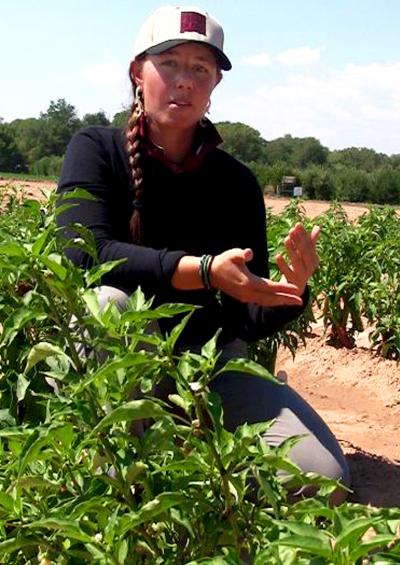NMSU studies drought stress, deficit irrigation impact on northern New Mexico chile

"Deficit irrigation is a really good way to conserve water because you are looking at actually how many plants you can realistically grow with the amount of water you have, rather than planting a quantity of plants and not having enough water for them to have maximum production," said Israel Calsoyas, a New Mexico State University graduate research assistant in the College of Agricultural, Consumer and Environmental Sciences.
Calsoyas has studied the impact of deficit irrigation on three cultivars of chile in northern New Mexico for the past two summers under the funding of New Mexico's Experimental Program to Stimulate Competitive Research.
Calsoyas' experiment is a part of the EPSCoR Acequia Interdisciplinary Research, which is exploring different aspects of acequia health and use in northern New Mexico. EPSCoR is committed to providing an environment in which New Mexico scientists and educators are fully competitive in climate change research and education.
"This is not a new idea," she said. "Indigenous farmers in arid regions have been using it way before any others were doing it."
But how does drought stress and deficit irrigation affect New Mexican's beloved chile?
"Communities in northern New Mexico have deep rooted traditions of cultivating landrace chile varieties, including Chimayo," Calsoyas said. "These varieties are highly adapted to growing conditions of the region and have been touted for greater ability to withstand stressful growing conditions compared to commercial cultivars."
The objective of the Calsoyas' experiment is to determine the effect of deficit irrigation on pungency, also known as heat level, extractable color, and overall yield in two commercial chile cultivars, Big Jim and Sandia, and a landrace cultivar, Chimayo.
"There are several types of deficit irrigation, including sustained and regulated," Calsoyas said, while standing in her research plot at NMSU's Sustainable Agriculture Science Center in Alcalde.
"Sustained deficit is where you apply a lesser amount of water to the plants throughout the whole season," she said. "Regulated is when you give the plants adequate amounts of water when they are fruiting and blossoming and for the rest of the season you apply less amounts of water."
The experiment used regulated deficit and sustained deficit irrigation simultaneously. In the beginning of the season the plants were given adequate amounts of water and once established watering cycles of seven, nine, 11 and 13 days were implemented.
"Chile growers in northern New Mexico usually irrigate their fields every seven days," Calsoyas said. "We wanted to see how different watering cycles would impact overall yield, extractable color, and pungency of the plants."
The preliminary results after the first season shows there that deficit irrigation did not impact pod color.
Pungency, or the pods' heat level, in the Sandia chile was impacted by the drought stress however the Big Jim and Chimayo heat units were not impacted.
The overall yield of the plants did not show any statistically significant results during the first season. The second season of data is being analyzed and results will be published.


